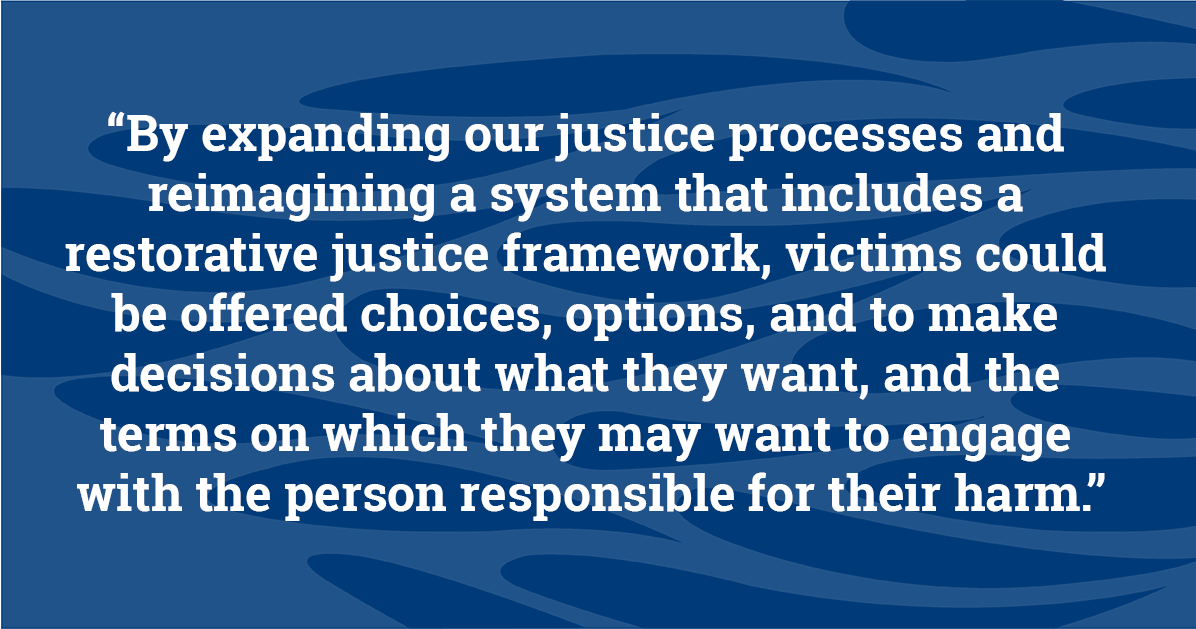Please note: Since publishing this article, The Cicada Project has become Transforming Justice Australia. Transforming Justice Australia is a survivor oriented and community based restorative justice practice for sexual abuse.

In Australia and overseas, alternative legal responses to sexual and domestic violence are increasingly being explored to better meet the needs of victims/survivors. One such alternative is restorative justice, which Thea Deakin-Greenwood and Jane Bolitho write offers an opportunity to refocus an otherwise adversarial (and sometimes inaccessible) process on the needs and rights of victims.
Given the current NSW Law Reform Commission inquiry into consent in relation to sexual offences, it’s timely to remember that reform beyond legislative change alone, such as restorative justice, is vital to improving access to justice for sexual assault victims-survivors.
For the Community Legal Centres NSW submission on consent law reform in NSW (February 2019), see here.
----------
Despite decades of law reform and progress in how the criminal justice system responds to sexual assault survivors, studies indicate conventional legal pathways continue to fail to meet victims’ needs(1) and sexual offences have the lowest conviction rates of any criminal offence.
While some victims do successfully access the Local and District Court system, resulting in some successful convictions at trial, in New South Wales as in many other jurisdictions, only a fraction of assaults are ever reported to Police (between 5-30%)(2), and from that point, only a small proportion of survivors ever have access to a “justice process” through the traditional legal pathways. In other jurisdictions within Australia as well as internationally, progress has been made to explore alternative approaches and responses to sexual and domestic violence, one such approach is to incorporate restorative justice processes and practices and to focus these responses around the victim/survivors needs.
In other jurisdictions within Australia as well as internationally, progress has been made to explore alternative approaches and responses to sexual and domestic violence. One such approach is to incorporate restorative justice processes and practices and to focus these responses around the needs of the victims/survivors.
The United Nations (2002) defines restorative justice in the criminal setting to be ‘any process in which the victim, the offender and/or any other individuals or community members affected by a crime actively participate together in the resolution of matters arising from the crime, often with the help of a fair and impartial third party’.(3)
Restorative justice hinges on three potentially powerful mechanisms for addressing harm.(4)
- Victim’s Voice
Restorative justice enables the victim to directly speak of the assault and provide a first-hand narrative of its harmful impact, unmediated through police statements, external parties or court processes.
- Validation
Restorative justice enables the perpetrator (and/or others involved) to bear witness to the victim’s narrative, and in so doing acquire some insight and potential accountability for their crime.
- Future Plan
Restorative justice focuses on finding solutions to the harm caused. In most cases, it includes a pragmatic plan to address the immediate and longer-term impacts. In so doing, it delivers to the victim a degree of justice, though not necessarily the end of their recovery journey.
In victim-focused restorative justice, emphasis is placed on the victim identifying all the components of harm (be they physical, social, emotional, material, symbolic or spiritual) before considering what restorative justice options could address all, some or none of these harms. Evidence indicates that the combination of these restorative justice processes provides victims with a counterpoint to the loss of power and control inherent in sexual assault.(5) Despite best efforts, this loss of power is also common to many victims’ experiences of current police and court processes.
Analysis of 15 restorative justice projects formally affiliated with criminal justice systems, and at least 29 other programs operating in the community in other parts of Australia and the world,7 reveals a number of success factors underpinning effective restorative justice practices.
- Robust assessment and screening
This ensures each participant is suited to the program and is aware of the options available before, during and after the restorative justice process.
- Flexibility and responsiveness processes
A ‘one-size-fits-all’ approach should be avoided to ensure each victim’s wishes and circumstances are responded to. For example, in some instances, the process may involve direct engagement with the perpetrator. In other cases, it may involve the facilitator undertaking communication on behalf of the victim. In others still, the victim’s focus may not be on the perpetrator, but rather on restoring relations with family members or friends impacted by the crime.
- Use of expert staff and facilitators
Staff and facilitators should be trained in sexual assault counselling and the dynamics of violence. Staff also need high-level skills in trauma-informed care and in the principles and practices of restorative justice.
- Thorough victim preparation
This includes providing appropriate lead times, to ensure the victim’s readiness in terms of perpetrator meetings and other planning processes.
- Voluntary participation
Participation must be voluntary for all parties throughout the process, including the ability to withdraw, defer or refer matters to the police at any time.(6)
In summary, empirical evidence suggests it is possible to practise restorative justice after sexual abuse, safely and with positive impact while supporting other important reforms such as a specialist domestic and family violence court. However, restorative justice is the primary and best-documented avenue through which victim-survivors and either direct perpetrators or institutional representatives can come together to have difficult, usually emotional conversations about what happened, why and to what effect.
Maintaining the current system of justice is not an option for victims and survivors of sexual and personal violence. However, to advocate for amendments to the criminal justice system alone means continuing to struggle with an adversarial system oriented around prosecutorial priorities rather than around victim survivor needs and rights.
By expanding our justice processes and reimagining a system that includes a restorative justice framework, victims could be offered choices, options, and to make decisions about what they want, and the terms on which they may want to engage with the person responsible for their harm.
Solicitors at Elizabeth Evatt Community Legal Centre working in collaboration with Jane Bolitho, UNSW are advancing robust discussion around restorative justice, which hopefully leads to reform, professional development for practitioners and the development of a pilot project option in NSW for survivors of sexual assault.
Written by Thea Deakin-Greenwood (Solicitor, Elizabeth Evatt Community Legal Centre) and Jane Bolitho (Senior Lecturer in Criminology, University of New South Wales).

